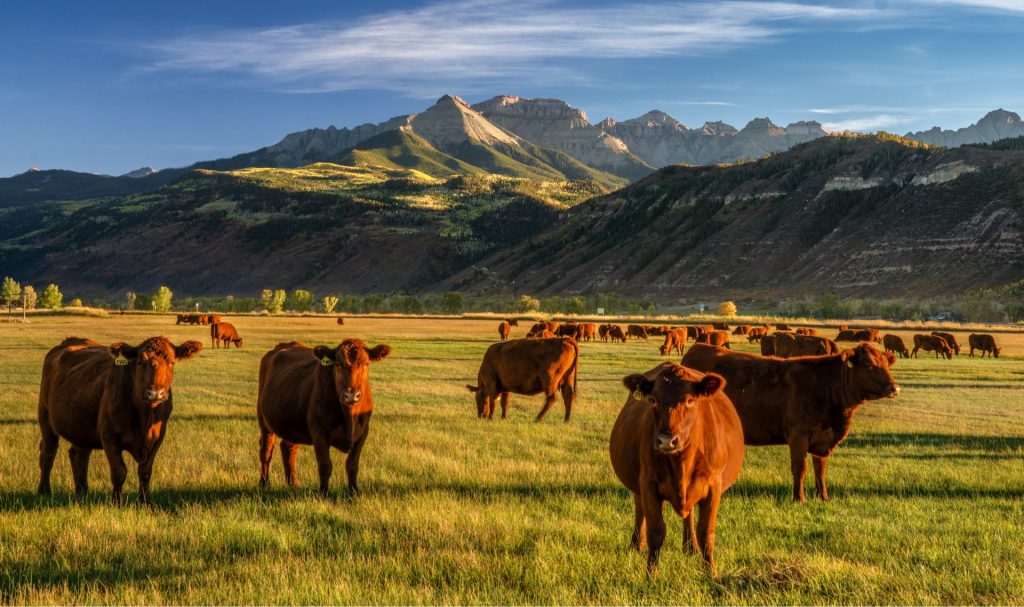With all of the new and buzzwordy labels given to meat sources today, it can be difficult to know what any of the designations mean. From organic to free range to hormone-free to grass-fed to “natural” – it takes some digging to understand what the labels mean in terms of meat quality, source, diet and overall environmental impact.

Free-Range Meat, Grass-Fed Beef, “Natural” Products & Organic Labels
There are important differences between free-range meat, grass-fed beef, and “natural” and “organic” products, mainly regarding the animals’ feed and their overall quality of life.
Free Range Meat
While most people are familiar with the term “free range” in relation to eggs and other poultry products, the USDA free-range designation extends to any animal that enjoys continuous access to the outdoors for more than 51% of its life. Any free-range meat that is not finished with grains is considered grass-fed meat. In general, grass-fed free-range meat is leaner, healthier and hormone-free.
Grass-Fed Beef
Grass-fed beef has grown in popularity over the years and can now be found in most grocery store meat departments. To be considered truly grass-fed, the animal’s diet must be “derived solely from forage consisting of grass (annual and perennial), forbs (e.g., legumes, Brassica), browse, or cereal grain crops in the vegetative (pre-grain) state” once the animal is weaned from its mother’s milk (per the USDA). Essentially, this means the animal’s diet is comparable to what it would eat in the wild.
And while a single free-range grass-fed cow consumes four to five tons of grass, hay and other native dry forage per year, free-range cattle – when managed correctly – can be both a sustainable meat source and also aid in sustainable farming practices. More on that later.
“Natural” vs “Organic” Beef
All fresh meat products can carry the “natural” label since the designation simply requires the product to be minimally processed (meaning not fundamentally altered from its natural state) and contain no artificial ingredients or added colors.
For meat products to be considered “organic,” USDA regulations require that the animal does not receive any hormones or antibiotics, is fed 100% organic feed and forage and has the ability to graze outdoors.
The Most Sustainable Meat: Regenerative Agriculture
While it’s true that raising livestock for meat, milk and eggs generates approximately 15% of all greenhouse gas emissions globally, there is a way to raise meat sustainably. Feedlots use a lot of energy – particularly because grain-based diets require a ton of fossil fuels, water, fertilizer and land to grow enough feed – and many pasture-based farming operations cause both erosion of the land and loss of biodiversity.
On the other hand, grass-fed free-range cattle and other livestock can provide ecological benefits, trap carbon in the soil and help reduce methane emissions as part of a regenerative agriculture framework. When livestock is allowed to roam freely yet carefully managed by rotating ranges from one section of land to another, free-range farming helps reduce erosion of the land, water contamination and air pollution, increases the biodiversity of the land through the natural spreading of manure and the trapping of carbon in the soil, and readies the land for future crop rotations to further regenerate precious topsoil for future generations of farmers and ranchers.
—
Grass-Fed Beef Jerky
We’re excited to announce our new free-range grass-fed beef jerky! Try some out today and let us know what you think in the comments below!
1 Comment
Permalink
Interesting read! An alternative to beef jerky is a beef stick. Beef sticks are made from chopped meat and are not as lean as jerky. To ensure that you buy organic beef sticks, it’s a good idea to choose a seller who has earned a reputation for offering healthy beef sticks exclusively.